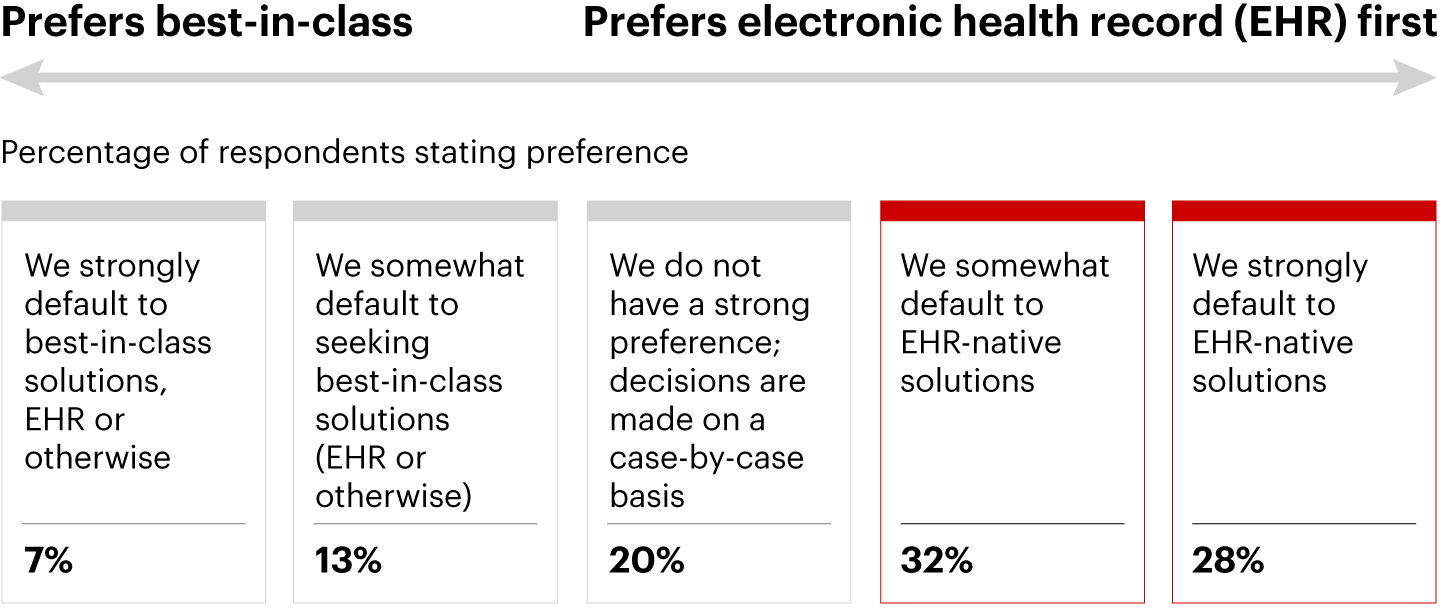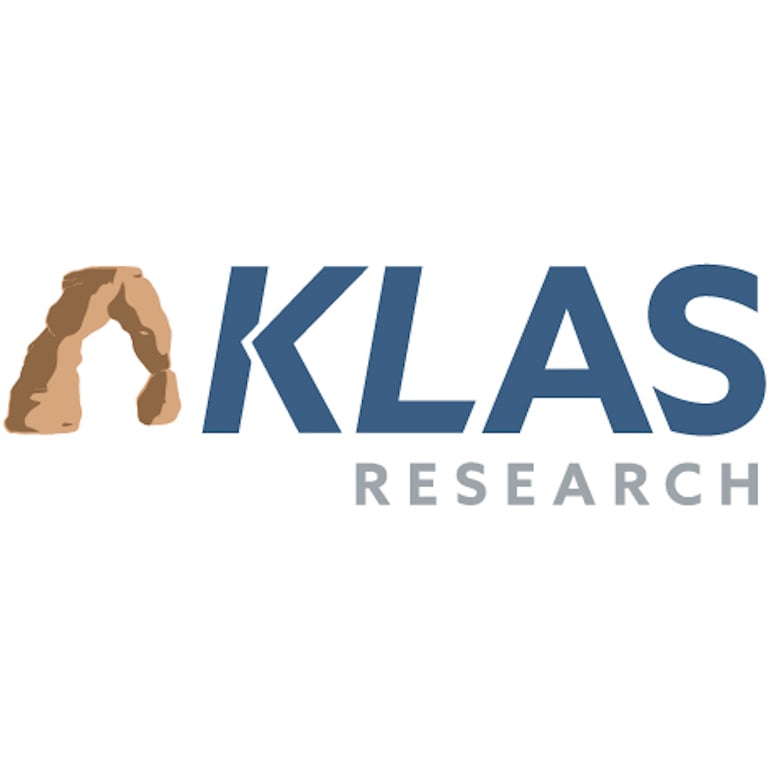As 2025 unfolds, providers and payers are navigating different macro pressures, but technology leaders in these organizations share the same imperative: Deploy tech to improve profit margins.
Providers, while past the volatile staffing swings of the Covid-19 era, still face structural workforce shortages. They also must contend with top-line pressures from rising uninsured patient volume and more assertive utilization management—along with payment integrity actions from payers.
Written in collaboration with
Written in collaboration with

Payers, meanwhile, are managing rising medical loss ratios and utilization while contending with heightened scrutiny around risk adjustment. They anticipate pressure on Medicaid and Affordable Care Act rolls following the One Big Beautiful Bill Act.
Uncertainty and macro pressures have not diminished the importance of IT, and spending on IT remains a high priority. At the same time, healthcare executives demand more of their technology vendors. Organizations are seeking solutions that address key business challenges and that pay for themselves through tangible impacts and with short time‑to‑value windows. The operating model for adoption is pragmatic: Pilot, prove, and scale.
Bain & Company and KLAS’s survey of 228 US healthcare executives provides a current view of where dollars are going and why.
Where providers are investing
RCM returns to primacy among providers, having been supplanted last year by IT infrastructure and cybersecurity spending in the wake of the Change Healthcare data breach (see Figure 1).
Revenue cycle management returns as providers’ overall high investment priority
Source: Bain 2025 Provider and Payer Healthcare IT Survey, n=228
RCM’s appeal lies in hard‑dollar ROI: Accurate documentation and coding, resulting in cleaner claims and fewer denials, lead to measurable gains on both the revenue and expense lines. The repetitive, rules‑based nature of RCM makes this function a natural proving ground for automation and generative AI. RCM, therefore, features prominently in AI activity, representing the four most common use cases currently: ambient documentation, clinical documentation improvement (CDI), coding, and prior authorization. Ambient documentation is furthest along, with roughly one-in-five providers at full rollout and another two-in-five in pilot.
Provider energy is increasingly shifting from back-end RCM processes to front-end and mid-cycle ones given the promise of ROI from upstream denial prevention. One chief information officer put it succinctly: “Every denial avoided is thousands of dollars we don’t have to chase.” This explains the strong momentum behind prior authorization and CDI, in particular (see Figure 2).
Providers report that documentation support, clinical documentation improvement, and medical coding are the top uses for AI
Note: Documentation support spans both electronic health record and revenue cycle management domains through improved note-taking and coding accuracy for billing and compliance
Source: Bain 2025 Provider and Payer Healthcare IT Survey, n=228
Private equity investment and tech partnerships amplify the signal. Recent moves—including the take‑private of R1 RCM by TowerBrook and Clayton, Dubilier & Rice and R1’s subsequent partnership with Palantir on AI‑powered agentic applications; new investment by Ontario Teachers’ Pension Plan alongside Goldman Sachs into Omega Healthcare and its alliance with Microsoft; and the formation of Smarter Technologies via the combination of Access Healthcare, SmarterDx, and Thoughtful.ai—aim toward infusing analytics and generative AI across revenue cycle operations.
Clinical workflow optimization also remains an important priority. Providers continue to invest in tools that improve throughput, support care quality goals, and reduce clinician burnout. KLAS data shows that across about 80% of measured organizations, fewer than 70% of clinicians agree that their electronic health record (EHR) system is fast. EHR latency and in-basket overload are the primary culprits, with IT infrastructure investment (including cloud migration) and further EHR optimization being powerful solutions. Because labor remains structurally scarce, improvements in clinician experience and productivity have a compounding effect.
Providers cite EHR integration, overall cost, interoperability, and data access as key technology pain points. Consequently, many seek to prioritize their EHR vendors for new solutions. About 6 in 10 providers take an EHR‑first approach when that vendor’s module is “good enough,” and about 20% are primarily best-of-breed buyers (see Figure 3). The EHR-first motion is especially pronounced among Epic customers, at 67% of respondents, while non-Epic customers seem more willing to entertain new vendors, with 46% taking the EHR-first line.
A majority of providers take an electronic health record–first mentality across solutions


Source: Bain 2025 Provider and Payer Healthcare IT Survey, n=228
When providers look beyond EHR, they most frequently do so in categories that are farther away from the clinical core. Enterprise resource planning/human capital management, governance/risk/compliance, and IT infrastructure/services are the categories most often cited for non-EHR adoption.
Where payers are investing
Care coordination and utilization management remain the top payer IT priorities for the second straight year. Within this category, plans are emphasizing prior authorization automation, improvements to care management workflows, and population‑level data aggregation and analytics to manage medical cost and close care gaps (see Figure 4).
Payers emphasize investments in member care coordination and utilization management along with network optimization and plan design
Source: Bain 2025 Provider and Payer Healthcare IT Survey, n=228
Provider-payer pilots in automated prior authorization are demonstrating material impact. For instance, in one Epic-Humana pilot, 75% of coverage checks were processed automatically, and registration time fell by about 90 seconds per patient. These are win-win outcomes, reducing administrative costs for both sides of the system.
Network optimization and plan design is the fastest-rising category. Payers have leaned into tools that help them assess provider performance and steer members toward high-quality care, which is critical to Medicare Advantage STAR performance. In commercial lines of business, employers are demanding affordability, renewing interest in tiered and narrower networks aligned with measurable outcomes.
Spending on value-based care enablement is accelerating, particularly around risk and quality applications. Roughly three-quarters of plan respondents expect spending in this category to grow faster than other IT priorities over the next three years. Modern data exchange and provider-payer collaboration is a key focus. For instance, payers are investing in tools that meet providers in their workflows and enable action at the point of care. Success requires aligned incentives as well as the ability of tools to accommodate heterogeneous payer requirements while driving consistent workflow across a provider’s entire patient panel.
Best‑of‑breed remains the default buying motion. Payers place total cost of ownership, functionality, and scalability ahead of suite convenience, and only a small minority cite ease of core administrative processing systems (CAPS) integration as a top selection criterion. National plans are more inclined to build their own tools; regional plans are more open to buying suites from their CAPS vendors.
AI adoption in payer operations is concentrating first in contact centers, member engagement/follow‑up, and underwriting and pricing. These domains benefit from personalization at scale and, by doing so, create meaningful value in member experience, enable better outcomes, and reduce administrative expenses (see Figure 5).
Payers have implemented AI mainly in call center operations, member follow-up and engagement, and underwriting and pricing
Source: Bain 2025 Provider and Payer Healthcare IT Survey, n=228
The outlook for AI
Providers and payers continue to express optimism about AI, viewing the technology as a strategic enabler. In last year’s survey, about 60% of providers and payers had an AI strategy in place or in active development. This year, the share has risen significantly: Some 70% of providers and about 80% of payers have an AI strategy in place or in development, reflecting a shift from broad exploration to focused execution. While uncertainty persists, leaders agree that inaction represents the riskiest path.
Provider results are encouraging. While many say it is still early to quantify precise financial returns, the qualitative read is positive. Fewer than 5% of providers surveyed indicated that the technology was not meeting expectations for categories in which AI solutions have been introduced; most are excited or very excited to scale up AI in those areas.
ROI outcomes have generally been positive on the payer side, too, although there are more instances of payers saying AI use cases have not met expectations, likely owing to the scale of internal IT and other operating resources available to assess the impact of AI. Still, payers appear excited to scale up generative AI use cases—notably for various forms of member/care navigation, in which they see an opportunity to engage members at a scale and level of personalization previously unimaginable.
A sharp, thoughtful focus will separate leaders from the rest of the pack. Organizations that succeed in capturing value from technology investments tend to prioritize a small number of high‑impact domains, pairing the technology with fundamental workflow and operating model changes. Given the magnitude of current investment, the onus is shared; vendors and customers need to ensure that value is captured repeatedly, not just proven once.

About KLAS Research
KLAS is a research and insights firm on a global mission to improve healthcare. Working with thousands of healthcare professionals and clinicians, KLAS gathers data and insights on software and services to deliver timely reports and performance data that represent provider and payer voices and act as catalysts for improving vendor performance. The KLAS research team publishes reports covering the most pressing questions facing healthcare technology today, including emerging technology insights, that provide early insights on the future of healthcare technology solutions. KLAS also fosters measurement and collaboration between healthcare providers and payers and best practice adoption. Learn more at https://klasresearch.com/.

